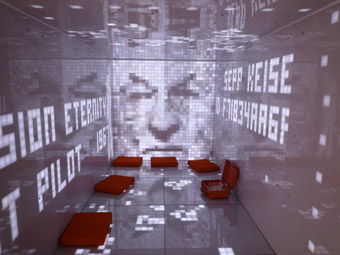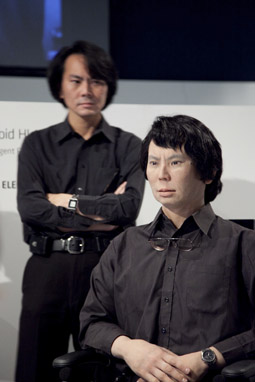human nature in the clouds
alexandra crosby: ars electronica 2009, linz, austria
![Bios [Bible], robotlab](https://www.realtime.org.au/wp-content/uploads/art/29/2960_crosby_ars_bible.jpg)
Bios [Bible], robotlab
photo Alex Davies
Bios [Bible], robotlab
I EXIT THE ALL DAY SYMPOSIUM ON CLOUD ACTIVISM A LITTLE CONFUSED. MY EYES ARE STILL FLICKERING FROM TRYING TO KEEP UP WITH THE THREE SIMULTANEOUS PROJECTIONS: THE ‘TWEETSCREEN’ (STREAM OF RELATED TWITTER FEEDS), THE LIVE IMAGE OF THE PRESENTERS AND THE SLIDES OF MAPS AND DATA. ALTHOUGH IT FEELS AS IF THE DISCUSSIONS HAVE BEEN AROUND ACTIVIST USES OF THE INTERNET, THE APPARENT CONCLUSION IS THAT ALL OF US NOW LIVE AND WORK IN A ‘CLOUD.’
Outside the Brucknerhaus auditorium, still thinking of clouds, I look up to see three vacuum-sealed figures suspended in large freestanding frames. This is Lawrence Malstaf’s performance, Shrink (see cover image). The physicality of these performances, staged three times a day during the festival, is a constant reminder of the sensitive relationship between our bodies and the insulating qualities of technological developments, whether we term them clouds, networks or some other metaphor.
The History Lounge downstairs in the Brucknerhaus celebrated the 30-year anniversary of Ars Electronica with a comprehensive retrospective of the festival including fantastic pieces such as Lifewriter (2006), by Christa Sommerer and Laurent Mignonneau. [You can see this act of typing unleashing a flood of creatures on YouTube. Eds] The works here have stood the test of time and remained poignant as society faces new issues, a difficult task in the dynamic world of electronic arts. Also exhibited here is a complete collection of the festival posters, reflecting how the event has branded itself with three decades of progressive themes, daring typography and curious imagery.
There was also plenty of exciting new work in the Prix CyberArts show at the OK Center for Contemporary Art. The strongest category was Hybrid Arts. Three very interesting and very different works received awards of distinction: Bios [Bible], EarthStar and the New York Times Special Edition. All point to the instability of social systems, namely religion, science and the media.
Bios [Bible] by the German group robotlab is an industrial robot that transcribes the Bible on scrolls of paper, producing the whole book over seven months. The precise movement of the calligraphic pen nib is mesmerising to watch, inviting us to consider how something produced ‘by hand’ could have such continuing impact on humanity. Australian artists David Haines and Joyce Hinterding present Earthstar as an exploration of the sun’s elemental and mythical qualities [see article RT88; see article RT89]. In a world dominated by images, their work aims to bring to our attention the unseen, using sound and scent, reintroducing the possibilities of sensory experiences to science. The New York Times Special Edition, by Steve Lambert and a herd of collaborators, was released on November 12, 2008, one week after the election of Barack Obama. The paper was distributed across the streets of New York City, Boston, Los Angeles and San Francisco with the headline “Iraq War Ends” and stories on a maximum wage, a new national public transit system and other hopeful prophecies. The aim of the authors was to suspend the disbelief of readers for at least 15 seconds in order to collectively imagine the idea of peace.
80+1/A Journey Around the World was an Ars Electronica project for the 2009 European Capital of Culture. The general idea was to exhibit several technologically driven approaches to the globalised future. Sound a little too wide-ranging and optimistic? The exhibition housed a very strange project called WIAWIA, Water in Africa, Water in Austria. In this work, a public toilet was installed, purportedly to be linked to an African village’s well via the internet. The water usage data gathered would be transmitted in real time and drive the flushing of the Linz toilet with the same amount of water being used in the village. It turns out the exchange is completely fictitious, as is the artist, Melissa Fatoumata Touré. In fact, it is an intriguing ‘creative hacking’ by German artist Niklas Roy looking at how arts festivals are desperate to include content from the underdeveloped world. If their global research radar was a little wider, I am sure Ars would not only have realised this earlier, but could have found some very interesting and genuinely African projects to exhibit. However, the choice to go ahead with the installation even after it was exposed as a hoax is a courageous one. It shows that even after 30 years, the festival still has the capacity to be self-reflexive. On the other hand, perhaps it was simply too late to cancel.
While the installation does encourage valuable skepticism of ‘feel good’ virtual collaboration, it is also intensely problematic. Firstly, the true nature of the project was revealed only in the festival display in the Brucknerhaus, complete with Photoshop images of the imaginary African village and stills from skype conversations with a digitally ‘blackened’ white German person wearing an Afro wig. The other display, in the main square of Linz, where the actual toilet is installed, has few hints to expose its illegitimacy. This exhibition has been open to Austria’s public for months, and has undoubtedly attracted a far bigger audience than the Ars Electronica Festival. So, is it fair game, even ‘subversive’, to dupe the general public as long as you let your fellow artists in on the joke? The second major issue is the representation by the artist himself as an African woman. He employs a series of racist stereotypes in the form of crude English language and naive imagery and we are left with nothing but another Eurocentric view of Africa, albeit an ironic one. I can’t help thinking such a project would never go down in Australia, Canada or the US, let alone, and perhaps most importantly, in Africa.

M∞ Sarcophagus, etoy.CORPORATION
photo Alexandra Crosby
M∞ Sarcophagus, etoy.CORPORATION
This year is the first time that the newly built Ars Electronica Centre has hosted the festival, and the four storey permanent exhibition takes a whole day to get through. Most impressive here is a temporary installation, unfortunately up some stairs and rather off the beaten track, of etoy’s fabulous M∞ Sarcophagus, part of the ongoing project, Mission Eternity. The ambitious aim of this work is to create a cult that can explore life after death in the digital age and “forever after.” The etoy.CORPORATION, most famous for their victory in the ‘toywar’ in the late 90s, defines the work as “a metaphysical adventure: an arcane network of computers, mortal remains, emotions, cargo containers, scientists, artists and hackers.” To view the process, we enter an immaculately designed shipping container. Inside are the digital and physical remains of pioneers of the information age who fit the criteria to be test pilots. So far there are two pilots: LSD guru and cyber writer Timothy Leary and Sepp Keiser, who broke new ground in microfilm and photocopying technologies in Switzerland. Keiser, in fact, is not yet deceased, but his contract with etoy ensures that when the time comes, his ashes will be cemented into the container’s pixel display. His digital portrait will be perpetually created, as fragments of safeguarded data are transmitted by thousands of ‘angels’ around the world.

Geminoid Hl-1, Hiroshi Ishiguro
photo Alex Davies
Geminoid Hl-1, Hiroshi Ishiguro
More than 300 events were packed into this year’s Ars Electronica. One of the stars of the week was Hiroshi Ishiguro’s clone of himself, Geminoid Hl-1, which can be operated remotely using complex network and sensor technology. Perhaps with my own Geminoid, I could have made it to all the performances, forums, and symposia during the festival, but without robotic assistance, I had to contend with the limits of human nature.
Ars Electronica 2009, Festival for Art, Technology and Society; Linz, Austria, Sept 3-8
For more images and information on Lawrence Malstaf’s Shrink see www.360cities.net/image/shrink-performance-ars-electronica-linz;
www.fortlaan17.com/artists/lawrence-malstaf
RealTime issue #93 Oct-Nov 2009 pg. 30






